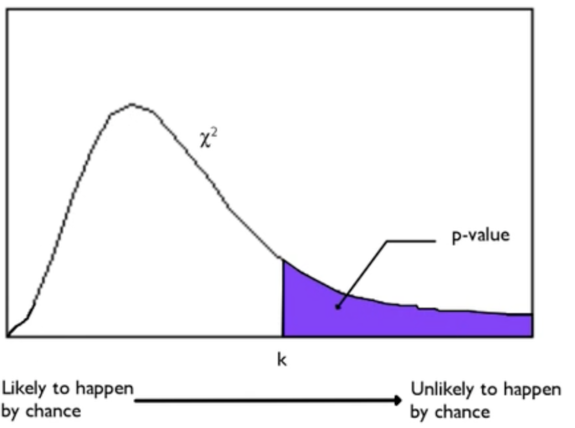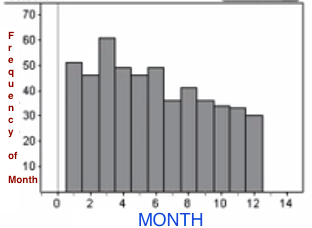Table of Contents |
Recall that the chi-square statistic is a particular test used to measure how the expected frequency differs from observed frequency.
Below is a visual representation of a chi-square distribution.

The chi-square distribution is a right-skewed distribution that generally measures the discrepancy from what a sample of categorical data would look like if you had an idea of what the population should look like in those categories.
Just like the t-distribution, the chi-square distribution is actually a family of curves. The shape changes a little bit, based on the degrees of freedom, but it's always skewed to the right.
The conditions for using the chi-square distribution are:
A chi-square test for goodness of fit is a method of testing the fit of three or more category proportions to a specified distribution. The null hypothesis is that the population distribution matches a specified distribution, while the alternative hypothesis is that the population does not match a specified distribution.
EXAMPLE
In the book Outliers, Malcolm Gladwell outlines a trend that he finds in professional hockey, related to birth month. Suppose a random sample of 512 professional hockey players was taken and their birth month was recorded.| Month | % of Population | Expected # of Hockey Players | Observed # of Hockey Players |
|---|---|---|---|
| January | 8% |
|
51 |
| February | 7% |
|
46 |
| March | 8% |
|
61 |
| April | 8% |
|
49 |
| May | 8% |
|
46 |
| June | 8% |
|
49 |
| July | 9% |
|
36 |
| August | 9% |
|
41 |
| September | 9% |
|
36 |
| October | 9% |
|
34 |
| November | 8% |
|
33 |
| December | 9% |
|
30 |
| Total | 512 | ||

What you would have expected is that of those 512 professional hockey players, 8% of them would have been born in January, 7% of them would have been born in February, etc. We can find the expected value for each month based on the given percentages of the population to get the following values:
| Month | % of Population | Expected # of Hockey Players | Observed # of Hockey Players |
|---|---|---|---|
| January | 8% | 40.96 | 51 |
| February | 7% | 35.84 | 46 |
| March | 8% | 40.96 | 61 |
| April | 8% | 40.96 | 49 |
| May | 8% | 40.96 | 46 |
| June | 8% | 40.96 | 49 |
| July | 9% | 46.08 | 36 |
| August | 9% | 46.08 | 41 |
| September | 9% | 46.08 | 36 |
| October | 9% | 46.08 | 34 |
| November | 8% | 40.96 | 33 |
| December | 9% | 46.08 | 30 |
| Total | 512 | 512 | |
We would have expected 9% of the players to have been born in each of July, August, September, October, and December. So, we would have expected 46.08. However, apparently just 30 were born in December.
Let's perform a chi-square test for goodness of fit for this set of data to determine the discrepancy:
| Condition | Description |
|---|---|
| Simple Random Sample | You can treat it as such. This was a sample of hockey players born between 1980 and 1990. There's no reason to imagine that it's going to be particularly different or unrepresentative. Therefore, you can treat this as a random sample of players who have played or will play professional hockey. |
| Independence | You have to assume that there are at least 10 times as many players who have ever played pro hockey as there were in our sample, such that we can assume that independence piece. That would mean that you have to assume that there are at least 5,120 players who have ever played pro hockey. |
| Expected Counts At Least 5 | The smallest number occurred in February, with 35.84. So, yes, when you look at the entire row of expected values, all of them are over 5. |

The chi-square statistic is going to be the observed minus the expected for each month squared, divided by the expected for each month.
| Month | Expected # of Hockey Players | Observed # of Hockey Players |

|
|---|---|---|---|
| January | 40.96 | 51 | 2.46 |
| February | 35.84 | 46 | 2.88 |
| March | 40.96 | 61 | 9.80 |
| April | 40.96 | 49 | 1.58 |
| May | 40.96 | 46 | 0.62 |
| June | 40.96 | 49 | 1.58 |
| July | 46.08 | 36 | 2.20 |
| August | 46.08 | 41 | 0.56 |
| September | 46.08 | 36 | 2.20 |
| October | 46.08 | 34 | 3.17 |
| November | 40.96 | 33 | 1.55 |
| December | 46.08 | 30 | 5.61 |
| Sum | 34.21 | ||
When you add all of those components together, you get the chi-square value of 34.21.
In this case, it's also a good idea to state the degrees of freedom, which is the number of categories minus 1. There were 512 hockey players, but there were 12 categories. So, the degrees of freedom is 12 minus 1, or 11.
The p-value can be obtained from technology or with a table. When using a table, you go down to the line that corresponds with the degrees of freedom and look for the chi-square value.
| χ2 Critical Values | |||||||||||||
|---|---|---|---|---|---|---|---|---|---|---|---|---|---|
| Degrees of freedom (df) | Tail Probability Values, p | ||||||||||||
| 0.250 | 0.200 | 0.150 | 0.100 | 0.050 | 0.025 | 0.020 | 0.010 | 0.005 | 0.0025 | 0.001 | 0.0005 | ||
| 1 | 1.32 | 1.64 | 2.07 | 2.71 | 3.84 | 5.02 | 5.41 | 6.63 | 7.88 | 9.14 | 10.83 | 12.12 | |
| 2 | 2.77 | 3.22 | 3.79 | 4.61 | 5.99 | 7.38 | 7.82 | 9.21 | 10.60 | 11.98 | 13.82 | 15.20 | |
| 3 | 4.11 | 4.64 | 5.32 | 6.25 | 7.81 | 9.35 | 9.84 | 11.34 | 12.84 | 14. 32 | 16.27 | 17.73 | |
| 4 | 5.39 | 5.59 | 6.74 | 7.78 | 9.49 | 11.14 | 11.67 | 13.23 | 14.86 | 16.42 | 18.47 | 20.00 | |
| 5 | 6.63 | 7.29 | 8.12 | 9.24 | 11.07 | 12.83 | 13.33 | 15.09 | 16.75 | 18.39 | 20.51 | 22.11 | |
| 6 | 7.84 | 8.56 | 9.45 | 10.64 | 12.53 | 14.45 | 15.03 | 16.81 | 18.55 | 20.25 | 22.46 | 24.10 | |
| 7 | 9.04 | 9.80 | 10.75 | 12.02 | 14.07 | 16.01 | 16.62 | 18.48 | 20.28 | 22.04 | 24.32 | 26.02 | |
| 8 | 10.22 | 11.03 | 12.03 | 13.36 | 15.51 | 17.53 | 18.17 | 20.09 | 21.95 | 23.77 | 26.12 | 27.87 | |
| 9 | 11.39 | 12.24 | 13.29 | 14.68 | 16.92 | 19.02 | 19.63 | 21.67 | 23.59 | 25.46 | 27.88 | 29.67 | |
| 10 | 12.55 | 13.44 | 14.53 | 15.99 | 18.31 | 20.48 | 21.16 | 23.21 | 25.19 | 27.11 | 29.59 | 31.42 | |
| 11 | 13.70 | 14.63 | 15.77 | 17.29 | 19.68 | 21.92 | 22.62 | 24.72 | 26.76 | 28.73 | 31.26 | 33.14 | |
| 12 | 14.85 | 15.81 | 16.99 | 18.55 | 21.03 | 23.34 | 24.05 | 26.22 | 28.30 | 30.32 | 32.91 | 34.82 | |
| 13 | 15.93 | 16.99 | 18.90 | 19.81 | 22.36 | 24.74 | 25.47 | 27.69 | 29.82 | 31.88 | 34.53 | 36.48 | |
| 14 | 17.12 | 18.15 | 19.40 | 21.06 | 23.68 | 26.12 | 26.87 | 29.14 | 31.32 | 33.43 | 36.12 | 38.11 | |
Going down to the line for 11 degrees of freedom, the closest to 34.21 is 33.14. This chi-square statistic corresponds with a probability of 0.0005. That's a very low p-value, much less than the significance level of 0.05.
This means that you must reject the null hypothesis in favor of the alternative and conclude that the distribution of birth months for professional hockey players differs significantly from the birth month distribution for the general populace.
IN CONTEXT
A manufacturing company claims that they expect five defects per day. This means that they believe the defects are evenly distributed across Monday through Friday.
A manager collects data on the days of the week and records the following information:
Day of the Week Expected # of Defects Observed # of Defects Monday 5 6 Tuesday 5 8 Wednesday 5 4 Thursday 5 2 Friday 5 5
Let's perform a chi-square test for goodness of fit to determine if the variation that we see in the observation is from random chance, or if there is something different than an even distribution.
Step 1: State the null and alternative hypotheses.
We can state these hypotheses with a significance level of 5%:
Step 2: Check conditions. Let's check the three conditions for this hypothesis test.
Step 3: Calculate the test statistic and p-value.
- Simple Random Sample: We can assume that the manager collected data randomly throughout the days of the week.
- Independence: You have to assume that there have been at least 10 times as many defects at this manufacturing company as there were in our sample, such that we can assume that independence piece. That would mean that you have to assume that there have been at least 250 defects in this company's history.
- Expected Counts At Least 5: When you look at the entire row of expected values, all of them are 5, so this condition is satisfied.
We can use the chi-square formula to calculate the chi-square test statistic and take the observed minus the expected, then square those value and divide by the expected, and finally sum everything that we find.
Day of the Week Expected # of Defects Observed # of Defects 
Monday 5 6 
Tuesday 5 8 
Wednesday 5 4 
Thursday 5 2 
Friday 5 5 
Sum 4
The chi-square test statistic for this data set is equal to 4. We can use a chi-square table or technology to find the p-value that relates to this value of the chi-statistic, 4. We also need to look at the degrees of freedom, which is the sample size minus 1, or 5 minus 1. So, in this case, the chi-square statistic and the degrees of freedom are both 4. Applying this information and using technology, we find a p-value of 0.40601.
Step 4: Compare your test statistic to your chosen critical value, or your p-value to your chosen significance level. Based on how they compare, state a decision about the null hypothesis and conclusion in the context of the problem.
Remember, our significance level was 0.05. In this case, our p-value is greater than our significance level, so we cannot reject our null hypothesis.
Source: THIS TUTORIAL WAS AUTHORED BY JONATHAN OSTERS FOR SOPHIA LEARNING. PLEASE SEE OUR TERMS OF USE.